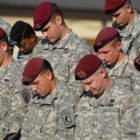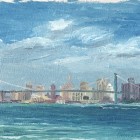August 27, 2011; Source: The Link | In the wake of the September 11th terrorist attacks, there were incidents reported around the U.S. of violent attacks on people of South Asian descent. For example, in New Jersey soon after the attacks, Rajinder Singh Khalsa, a Sikh who wears the mandatory Dastar, or turban, was “accosted by individuals who insisted that he remove the ‘dirty curtain’ on his head,” according to a report in The Link. Khalsa’s attackers were apparently in search of someone to harass who looked like what they imagined the 9/11 hijackers to look like. The Link story goes on to say that “after [Khalsa] reported the incident to the police, his attackers threatened to beat him to unconsciousness and threatened to kill him.”
The South Asian community in the U.S. is fast-growing and extremely diverse. It includes individuals with ancestry from Bangladesh, Bhutan, India, Nepal, Pakistan, Sri Lanka, and the Maldives, as well as members of the South Asian diaspora around the world. The region is home to followers of a wide variety of religions, including Buddhism, Christianity, Hinduism, Jainism, Judaism, Islam, and Zoroastrianism—as well as Khalsa’s faith, Sikhism.
Khalsa lived in Jersey City, one of the major centers of South Asian immigrants in the U.S. At the end of July, a nonprofit called South Asian Americans Leading Together (SAALT) organized a hearing in Jersey City to address issues surrounding the 9/11 experience. People talked about the anti-Asian backlash of the time and shared good news as well, such as the resolutions approved just the night before by the Passaic and Teaneck, New Jersey boards of education to enforce the state’s “Anti-Bullying Bill of Rights” and to train students and employees about cultural and religious-practice sensitivity. Both resolutions were presented by SAALT.
Sign up for our free newsletters
Subscribe to NPQ's newsletters to have our top stories delivered directly to your inbox.
By signing up, you agree to our privacy policy and terms of use, and to receive messages from NPQ and our partners.
The hearing also addressed advocacy strategies such as replicating the Teaneck and Passaic resolutions, working with media outlets to raise awareness of religious practices, building partnerships with other ethnic and religious communities, and getting involved in civic and political issues at the local level.
Sometimes we as a nation and in the nonprofit sector make gross generalizations about ethnic, racial, and religious groups and fail to see distinctions within broad categories such as “Hispanic” or “Asian American.” The number of Indian-Americans (those with ancestors born or native to India) increased from 1.7 million in 2000 to more than 2.8 million in 2010. There were 210,000 Pakistani-Americans in the U.S. as of 2005, probably two or three times more than that as of 2010. The Bangladeshi population in the U.S. was 57,000 in 2000, 143,000 in 2007, and probably many more now. SAALT held another hearing in Los Angeles on August 20.—Rick Cohen













